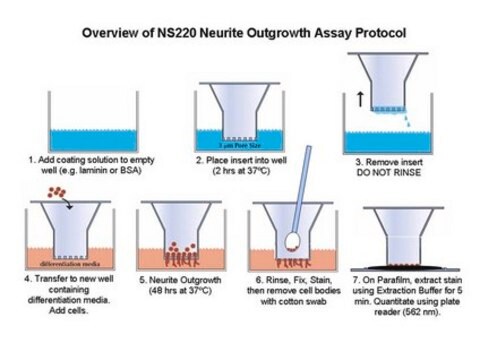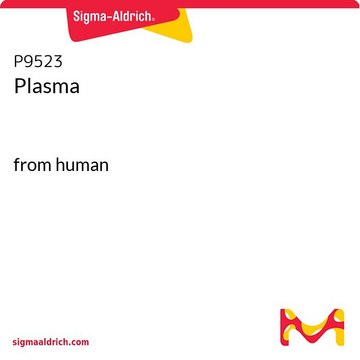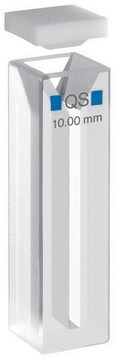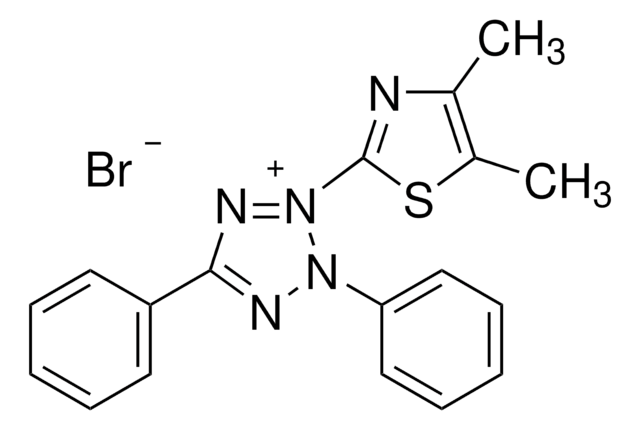NS225
Neurite Outgrowth Assay Kit (1 µm)
The NS225 Neurite Outgrowth Assay Kit (1 μm) is based on the use of Millicell cell culture inserts (chambers) containing a permeable membrane with 1 μm pores at the base.
Sinónimos:
Neurite growth assay
Iniciar sesiónpara Ver la Fijación de precios por contrato y de la organización
About This Item
UNSPSC Code:
12352207
eCl@ss:
32161000
NACRES:
NA.84
Productos recomendados
Quality Level
species reactivity (predicted by homology)
all
manufacturer/tradename
Chemicon®
technique(s)
cell based assay: suitable
detection method
colorimetric
shipped in
wet ice
General description
Application CHEMICON′s NS225 Neurite Outgrowth Assay Kit (1 μm) utilizes microporous tissue culture insert technology from Millipore and is based on the use of Millicell cell culture inserts (chambers) containing a permeable membrane with 1 μm pores at the base. The inserts are designed to fit into a receiver vessel, which when in use contains differentiation media in contact with the bottom of the insert membrane. The permeable membranes allow for discrimination between neurites and cell bodies, as projecting neurites will pass easily through the pores but cell bodies will not. Therefore, by inducing neurites to traverse these membrane pores, a purified population of neurites is located on the underside of the membrane, distal to the surface on which neural cell bodies are deposited. This kit has has been specifically designed for and validated with PC12 cells. The diameter of PC12 cell bodies is relatively small compared to that of many other cell types commonly used in neurite outgrowth assays [5, 6, 7]. As a result, many PC12 cell bodies may pass though pores larger than 1 μm, significantly obscuring neurite outgrowth assay results. Using a 1 μm pore size greatly reduces background and improves the signal-to-noise ratio in studies using PC12 cells. Use of this 1 μm pore size with larger cell types that extend wider diameter neurites, e.g., N1E-115 cells, will greatly diminish the number of neurites able to project through to the underside of the membrane, and is thus not recommended. The assay is a simple, efficient, and versatile system for the quantitative determination of compounds that influence neurite formation and repulsion. With this system, it is possible to screen numerous biological and pharmacological agents simultaneously, directly evaluate adhesion and guidance receptor functions responsible for neurite extension and repulsion, as well as analyze gene function in transfected cells. The microporous filter allows for biochemical separation and purification of neurites and cell bodies for detailed molecular analysis of protein expression, signal transduction processes and identification of drug targets that regulate neurite outgrowth or retraction processes. Reagents and materials supplied in the NS225 Neurite Outgrowth Assay Kit are sufficient for 12 tests.
Application
The NS225 Neurite Outgrowth Assay Kit (1 μm) is based on the use of Millicell cell culture inserts (chambers) containing a permeable membrane with 1 μm pores at the base.
Components
Neurite Outgrowth Plate Assembly, 1 µm: (Part No. 2007254) 1 x 24-well plate containing 12 x Millicell hanging inserts with 1 µm pore size membranes.
Neurite Stain Solution: (Part No. 90242) One 20 mL bottle.
Neurite Stain Extraction Buffer: (Part No. 90243) One 20 mL bottle.
Neurite Outgrowth Assay Plate: (Part No. 2007255) Two 24-well plates.
Cotton Swabs: (Part No. 10202) 50 swabs.
Forceps: (Part No. 10203) One each.
Neurite Stain Solution: (Part No. 90242) One 20 mL bottle.
Neurite Stain Extraction Buffer: (Part No. 90243) One 20 mL bottle.
Neurite Outgrowth Assay Plate: (Part No. 2007255) Two 24-well plates.
Cotton Swabs: (Part No. 10202) 50 swabs.
Forceps: (Part No. 10203) One each.
Storage and Stability
When stored at 2-8° C, the kit components are stable up to the expiration date. Do not freeze or expose to elevated temperatures. Discard any remaining reagents after the expiration date.
Legal Information
CHEMICON is a registered trademark of Merck KGaA, Darmstadt, Germany
Disclaimer
Unless otherwise stated in our catalog or other company documentation accompanying the product(s), our products are intended for research use only and are not to be used for any other purpose, which includes but is not limited to, unauthorized commercial uses, in vitro diagnostic uses, ex vivo or in vivo therapeutic uses or any type of consumption or application to humans or animals.
signalword
Danger
hcodes
Hazard Classifications
Eye Irrit. 2 - Flam. Liq. 2
Storage Class
3 - Flammable liquids
Certificados de análisis (COA)
Busque Certificados de análisis (COA) introduciendo el número de lote del producto. Los números de lote se encuentran en la etiqueta del producto después de las palabras «Lot» o «Batch»
¿Ya tiene este producto?
Encuentre la documentación para los productos que ha comprado recientemente en la Biblioteca de documentos.
Yue Tang et al.
Life sciences, 91(19-20), 951-958 (2012-09-25)
It is well known that neural stem/progenitor cells (NS/PC) are an ideal cell type for the treatment of central nervous system (CNS) disease. However, ethical problems have severely hampered fetal NS/PC from being widely used as a source for stem
D G Drubin et al.
The Journal of cell biology, 101(5 Pt 1), 1799-1807 (1985-11-01)
Nerve growth factor (NGF) regulates the microtubule-dependent extension and maintenance of axons by some peripheral neurons. We show here that one effect of NGF is to promote microtubule assembly during neurite outgrowth in PC12 cells. Though NGF causes an increase
P Lamoureux et al.
The Journal of cell biology, 110(1), 71-79 (1990-01-01)
Several groups have shown that PC12 will extend microtubule-containing neurites on extracellular matrix (ECM) with no lag period in the absence of nerve growth factor. This is in contrast to nerve growth factor (NGF)-induced neurite outgrowth that occurs with a
M T Filbin
Current biology : CB, 10(3), R100-R103 (2000-02-19)
Myelin is a potent inhibitor of axon regeneration, but has been viewed as just one of many factors that prevent regeneration after injury. So it comes as a surprise that immunization against myelin has been found to allow extensive axon
J Qiu et al.
Glia, 29(2), 166-174 (2000-01-14)
The lack of axonal regeneration in the adult mammalian CNS is due to both unfavorable environmental glial factors and the intrinsic neuronal state. Inhibitors associated with myelin and the glial scar have been extensively studies and it has been shown
Artículos
Optimized cell based neurite outgrowth assays and reagents to study neuron function and development.
Nuestro equipo de científicos tiene experiencia en todas las áreas de investigación: Ciencias de la vida, Ciencia de los materiales, Síntesis química, Cromatografía, Analítica y muchas otras.
Póngase en contacto con el Servicio técnico










